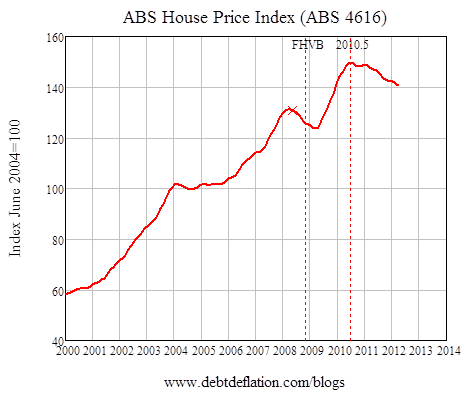Econintersect: The Reserve Bank of Australia made the ninth key interest rate cut in 23 months today (06 August 2013) as the country tries to compensate for the rapid contraction in the mining sector. Mining had been in a multi-year boom as a result of the rapid growth in demand from Asia countries, especially China, in the early years of the 21st century. Since the middle of last year the mining sector growth started to slow, according to Australian Mining.

The new rate (“cash rate”) announced by the RBA (Reserve Bank of Australia) is 2.5%, down from 4.75% since September 2011. The statement by RBA Governor Glenn Stevens sounded rather benign:
In Australia, the economy has been growing a bit below trend over the past year. This is expected to continue in the near term as the economy adjusts to lower levels of mining investment. The unemployment rate has edged higher. Recent data confirm that inflation has been consistent with the medium-term target. With growth in labour costs moderating, this is expected to remain the case over the next one to two years, even with the effects of the recent depreciation of the exchange rate.
The Australian dollar (AUD) has declined by 15% against the U.S. dollar (USD) and 16% against the Japanese yen (YEN) since April. Over the past year AUD-USD is down 16% and AUD-YEN is up 6%. The AUD rallied after the announcemnt as the market seemed to interpret the events as indicating a bias toward further easing was removed.
The benign nature of Stevens’ assessment for Australia loses some credibility when compared to another statement he made:
Recent information is consistent with global growth running a bit below average this year, with reasonable prospects of a pick-up next year. Commodity prices have declined but, overall, remain at high levels by historical standards. Inflation has moderated over recent months in a number of countries.
While the chances for a pick-up next year may be arguably correct, few are calling the 1% growth in the U.S. and the near zero growth in the Eurozone as “a bit below average“.
The rate cuts have had mixed economic results. A slump in house prices has reversed but GDP has been in a five quarter growth decline.
House prices fell 10% from a 2010 peak into early 2012.

Coinciding with the interest rate cuts house prices have increased by an average of 5% across eight major Australian markets. The following table is from Macro Business:

However, after an initial surge GDP has declined steadily over the last five quarters (through 1Q 2013) as shown in the following graphic from Trading Economics:

Sources:
- Statement by Glenn Stevens, Governor: Monetary Policy Decision (Press Release, Reserve Bank of Australia, 06 August 2013)
- Australia cuts rates to record low (Neil Hume, Financial Times, 06 August 2013)
- Finance sector downbeat on mining sector (Malavika Santhebennur, Australian Mining, 12 June 2013)
- Australia cuts rate 25 bps, says AUD higher than expected (Central Bank News, 03 December 2012)
- Australian House Prices down 10% from Peak (Steve Keen, Credit Writedowns, 01 May 2012)
- ABS: House prices jump in June quarter (Unconventional Economist, Macro Business, 06 August 2013)
- Australia GDP Annual Growth Rate (Trading Economics)







